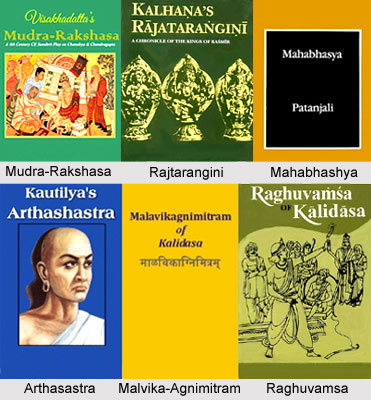 Leaving religious works, there are other works, which are quite imperative for furnishing historical stuffs for the restructurisation of history of ancient India. Such works can be classified under several heads, like the Biographical Literature, Chronicles, Works on Politics and Grammar, Classical Sanskrit Literature and Scientific Works. A concise description of these works and their significance is illustrated below-
Leaving religious works, there are other works, which are quite imperative for furnishing historical stuffs for the restructurisation of history of ancient India. Such works can be classified under several heads, like the Biographical Literature, Chronicles, Works on Politics and Grammar, Classical Sanskrit Literature and Scientific Works. A concise description of these works and their significance is illustrated below-
Biographical Work-The chief biographical works are listed as follows-
(i) Harsha Charita-It was penned in prose-form by Bana in 7th century A.D., and attracts immense importance, because it sketches the life of Emperor Harshavardhana and the political history of 7th century A.D.
(ii) "Vikramakdeva Charit" and Gaudavaho-These were scripted by Bilhanana and Vikpati respectively and delineates the feats of Yashovarman and Vikramaditya in two epics.
(iii) Prithvi Raj Raso-Written by Chandbardai, this enlightens a reader about King Prithviraj. Though these works cannot be named authentic historical works, yet they furnish readers with very valuable historical materials about their individual periods. Other works which come under this category are `Kumar-Pala-Charita` by Hema Chandra, `Ram Charit` by Sandhyakar-Nandi, `Prithiviraj Vijay` by Jayanak and `Ballal-Charit` by Anand Bhatt. But these later works are so saturated with imagination, that it is pretty futile to elicit historical materials from them.
Chronicles
(i) Rajtarangini-Scripted by Kalhana in 1149-50, this is the most substantial work under this head. It speaks about the history of Kashmir. From this book, one can obtain a very unquestionable chronicle of history of that era, and hence is a very helpful book. Dr. Majumdar remarks that Kalhana`s `Rajtarangini` is the only historical book in the strictest sense of the term in the entire ancient Indian literature.
Other chronicles which also supplies some materials of historical value comprise `Ras-Mala` of Gujarat and Kirti-Kaumudi` by Someshvara of Nepal and Assam.
Works on Politics and Grammar
(i) Kautilya`s `Arthasastra`-It is the most imperative source for the restructurisation of the history of Mauryas. It is believed to belong to 4th century B.C. It is the oldest and biggest work on Science of Politics. Kautilya paints a brilliant picture of the political, social and religious life of people of that period. His book is a magnum opus on the art of principles of administration.
(ii) Nitisastra-It was penned by Kamandaka, disciple of Kautilya and was approximately written during the Gupta period.
Grammatical Works
(iii) Panini`s `Ashtadhayayi`-Written by Panini, it sheds light upon the cultural history of the Mauryas.
(ii) Patanjali`s `Mahabhashya`-Belonging to 2nd century B.C., Patanjali was the contemporary of Pushyamitra Shunga. His book furnishes constructive accounts of Greek invasions.
Classical Sanskrit Literature
(i) Mudra-Rakshasa-Sketched by Vishakha Datta, this drama delineates the wipeout of the Nanda dynasty by Chandra Gupta Maurya.
(ii) Malvika-Agnimitram-Written by Kalidasa, it incorporates references to the war between Pushyamitra and the Greeks.
(iii) Raghuvansa-Written by Kalidasa, it portrays the journey of Raghu, who was either Samudra Gupta or Chandra Gupta II.
In addition to these, other historical dramas include- `Chintamani` by Merutonga and `Prabandh Kosh` by Rajashekhara.
Scientific Works
In the domain of scientific works, `Surya-Sidhanta` and `Romak Sidhanta` by Aryabhatta are foremost works in astronomy. `Charak Samhita` and `Susruta Samhita` are substantial works on medical science. These works also provide specific functional historical materials.



















